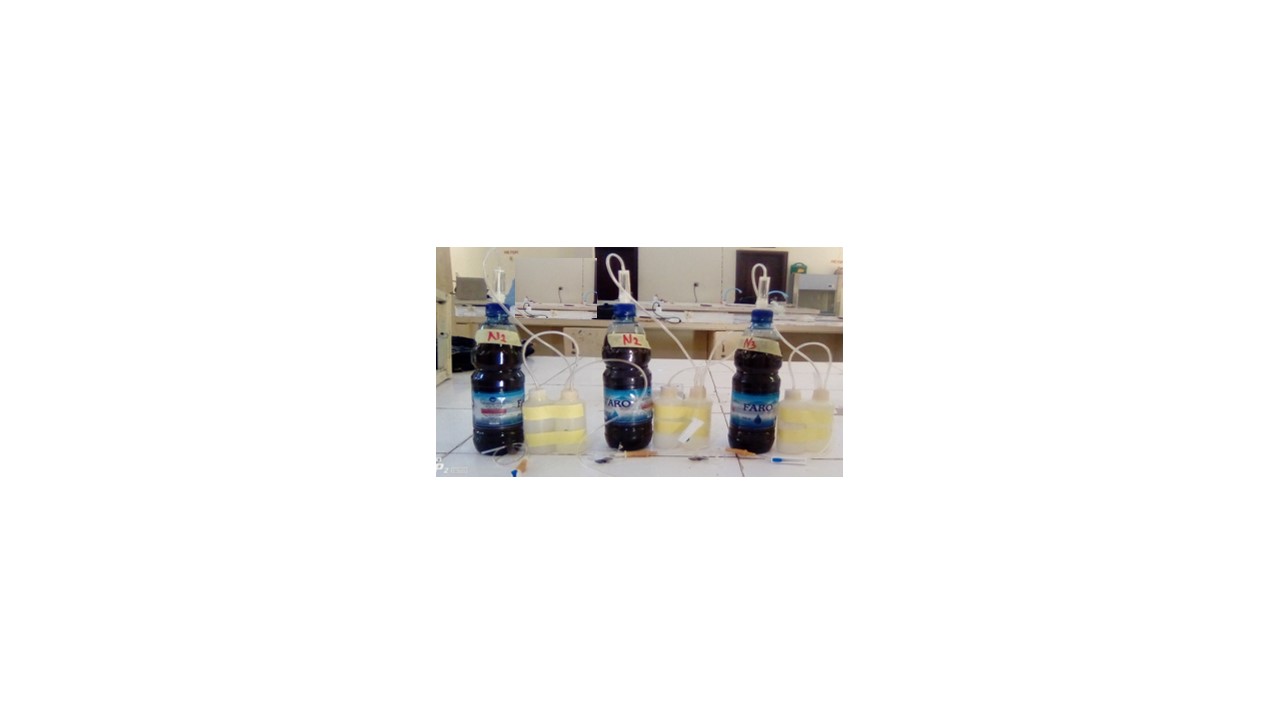Biogas production from cow dung using laboratory scale digester as potential tool for abattoir waste management
DOI:
https://doi.org/10.54117/gjpas.v1i1.13Keywords:
Biogas, Cow Dung, Digester, Physiochemical parameters, Anaerobic digestionAbstract
The main challenge of the present world is to harness energy source which is environment friendly and ecologically balanced because the use of fossil fuels has led to global climate change, environmental degradation, and human health problems. This has forced the world to search for another alternate energy source, such as biogas. Biogas typically refers to a gas produced by the breakdown of organic matter in the absence of oxygen. Cow dung as a renewable source of energy supply has been proven to be very efficient. This work is focused on production of biogas using cow dung as a means of abattoir waste management. A laboratory scale digester was constructed using three 750ml capacity plastic water bottles with slurry concentration of 1500g cow dung per 3000cm3 distilled water over a retention time of three weeks. The biogas production started on the fourth day of fermentation and followed an increasing trend. Reaching its peak on the seventeenth day before a gradual fall in production rate. The average weekly production of biogas are; day1-7 (17.33cm3), day 8-14 (99.00cm3), day 15-21(172.33cm3). The result obtained from this study also indicates that Bacillus species were the most common bacteria isolated
References
Abubakar, B.S. and Ismail N. (2012). Anaerobic digestion of cow dung for biogas production. ARPN Journal of Engineering and Applied Sciences.,7 (2):169-172.
Adeyanju, A. A. (2008). Effect of Seeding of Wood-Ash on Biogas Production using Pig Waste and Cassava Peels. Journal of Engineering and Applied Sciences. 3:242-245.
Ahmadu, T. O. (2009). Comparative Performance of Cow Dung and Chicken Droppings for Biogas Production, M.Sc. Thesis Submitted to the Department of Mechanical Engineering, Ahmadu Bello University, Zaria.
Akinbami, J.F.K., Ilori, M.O., Oyebisi, T.O., Akinwuni, I.O., and Adeoti O. (2001). Biogas energy use in Nigeria: current status, future prospects and policy implications. Renewable, Sustainable Energy Review. 5: 97-112.
Babatola, J.O. (2008). Comparative study of biogas yield pattern in some animal and household wastes. African Research Review., 2(4):54-68.
Bagudo, B.A. (2012). “Fermentation and methanogenic characteristics of leafy biomass feedstocks in a solid phase biogas fermenter”. Bioresources Technology 62 (2012):71-78.
Baki, A.S. (2004). “Isolation and identification of microbes associated with biogas generation at different retention time using cow dung”. M.sc dissertation, submitted to department of Microbiology Usmanu Danfodio University Sokoto Nigeria.
Bello, A. (2019). “Biogas Generation Using Cattle Rumen Contents”. Acta Scientific Medical Sceinces 3.4: 22-30.
Carucci, C., F. Carrasco, K. Trifoni, M. Majone and M. Beccari. (2005). Anaerobic digestion of food industry waste: effect of codigestion on methane yield. J. Environ Eng.131(7): 1037–1045.
Fariku, S., and Kidah, M.I. (2008). Biomass Potentials of Lophira lanceolata Fruit as a Renewable Energy Resource. Africa Journal of Biotechnology 7: 308-310. Friends of the Earth (2007). Briefing on Anaerobic Digestion. Available On http://www.fao.co.uk/AnaerobicDigestion/September-2007.pdf.
Garba, B and Atiku S. (1992). “Effect of some operating parameters on Biogas production rate”.Nigeria Journal of Renewable Energy 6.3 (1992): 343-344.
Godi, N.Y.,Zhengwuvi, L.B., Abdulkadir, S and Kamtu, P. (2013) Effect of cow dung variety on biogas production. Journal of Mechanical Engineering Research., 5(1):1-4.
Gomez, L.D., Steele-King C.G. and McQueen-Mason S.J. (2008). Sustainable liquid biofuels from biomass: the writing’s on the walls, New Phytologist, 178: 473-485.
Kabouris, J.C., U. Tezel, S.G. Pavlostathis and R.A. Gillette. (2008). The anaerobic biodegradability of municipal sludge and fat, oil, and grease at mesophilic conditions, Water Environ. Res. 80: 212–221.
Kossmann, W., Pontz, U., Habermehl, S. and Hoerz, T. (2001). Biogas Digest, Vol II: Biogas – Application and product Development pp 4 - 11, 19 -25 and 25 -80
Labatut, A.R., Angenent, T. L. and Scott, R. N. (2010). Biochemical methane potential and biodegradability of complex organic substrates, Bioresour. Technol. 102: 2255–2264.
Li, Y.Y., Sasaki, H., Yamashita, K., Seki, K., and Kamigochi, I. (2002). High-rate methane fermentation of lipid-rich food wastes by a high-solids co-digestion process. Water Sci. Technol. 45(12): 143–150.
Rabah, A. B., Baki, A. S., Hassan, L. G., Musa, M. And Ibrahim, A. (2010) Production of Biogas using abattoir waste at different retention. Science World Journal,5 (4):23-26.
Richards, B., Herndon, F. G., Jewell, W. J., Cummings, R. J and White, T. E. (1994) In situ methane enrichment in methanogenic energy crop digesters. Biomass and Bioenergy., 6(4): 274–275.
Ukpai, P. A. and Nnabuchi, M. N. (2012). Comparative study of biogas production from cow dung, cow pea and cassava peeling using 45 litres biogas digester. Advances in Applied Science Research. 3 (3):1864-1869.

Downloads
Published
Issue
Section
License
Copyright (c) 2022 Gadau Journal of Pure and Allied Sciences

This work is licensed under a Creative Commons Attribution 4.0 International License.

